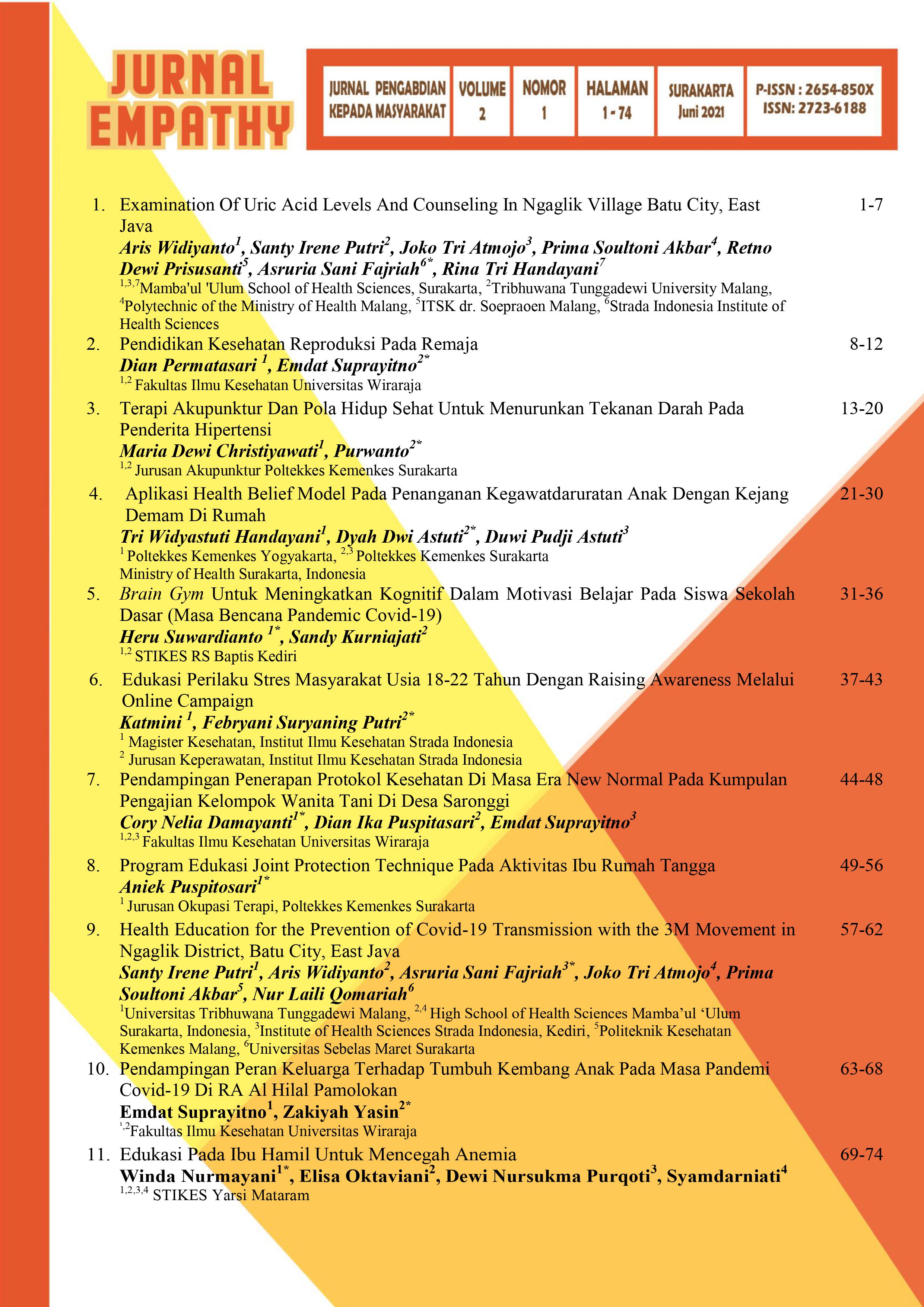Examination Of Uric Acid Levels And Counseling In Ngaglik Village Batu City, East Java
Main Article Content
Abstract
Background: Uric0acid0is0a0produc0of0purine0metabolism. There are several causes of gout, including changes in diet, consumption of drugs, and alcohol consumption. The purpose of implementing this community service activity is to provide education to the community in Ngaglik Village and to check uric acid levels. Based on the team's observations on several residents in Ngaglik Village, it was found that most residents did not have sufficient knowledge about gout and did not carry out routine health checks. Methods: In order to increase awareness and understanding of residents about health care efforts, especially preventing gout, the team coordinated with the urban village to carry out community service activities in Ngaglik Village, Batu City, East Java. The target in implementing this program is all residents in the Ngaglik Village, Batu City. Community service activities were carried out on April 6, 2021, attended by the village head and also village officials and babinsa. Results: The result that has been achieved in this service is that all of the people present have undergone examination and counseling. Conclusion: After carrying out the activity, it is hoped that the community can follow up on the results of the examination and improve the behavior of efforts to prevent gout.
Article Details
How to Cite
References
Alqarni, N. A., & Hassan, A. H. (2018). Knowledge and practice in the management of asymptomatic hyperuricemia among primary health care physicians in Jeddah, Western region of Saudi Arabia. Saudi Medical Journal, 39(12), 1218–1225. https://doi.org/10.15537/smj.2018.12.23715
Anothaisintawee, T., Lertrattananon, D., Thamakaison, S., Reutrakul, S., Ongphiphadhanakul, B., & Thakkinstian, A. (2017). Direct and Indirect Effects of Serum Uric Acid on Blood Sugar Levels in Patients with Prediabetes : A Mediation Analysis. 2017. https://doi.org/10.1155/2017/6830671
Barsoum, R., & El-Khatib, M. (2017). Uric acid and life on earth. Journal of Advanced Research, 8(5), 471–474. https://doi.org/10.1016/j.jare.2017.06.001
Engel, B., Just, J., Bleckwenn, M., & Weckbecker, K. (2017). Treatment options for gout. Deutsches Arzteblatt International, 114(13), 215–222. https://doi.org/10.3238/arztebl.2017.0215
Harrold, L. R., Mazor, K. M., Peterson, D., Naz, N., Firneno, C., & Yood, R. A. (2012). Patients knowledge and beliefs concerning gout and its treatment: A population based study. BMC Musculoskeletal Disorders, 13(1), 1. https://doi.org/10.1186/1471-2474-13-180
Jakše, Boštjan, B. J., & Pajek, M. P. and J. (2019). Uric Acid and Plant-Based Nutrition. 11, 1–15.
Jin, M., Yang, F., Yang, I., Yin, Y., Luo, J. J., Wang, H., & Yang, X. F. (2012). Uric acid, hyperuricemia and vascular diseases. Frontiers in Bioscience, 17(2), 656–669. https://doi.org/10.2741/3950
Kakutani-Hatayama, M., Kadoya, M., Okazaki, H., Kurajoh, M., Shoji, T., Koyama, H., … Yamamoto, T. (2017). Nonpharmacological Management of Gout and Hyperuricemia: Hints for Better Lifestyle. American Journal of Lifestyle Medicine, 11(4), 321–329. https://doi.org/10.1177/1559827615601973
Pasalic, D., Marinkovic, N., & Feher-Turkovic, L. (2012). Uric acid as one of the important factors in multifactorial disorders - facts and controversies. Biochemia Medica, 22(1), 63–75. https://doi.org/10.11613/bm.2012.007
Tamboto, R. R., Sahelangi, O., & Robert, D. (2016). Pengaruh Konseling Gizi terhadap Asupan Makanan Tinggi Purin dan Kadar Asam Urat pada Pasien Gout Arthtritis di Puskesmas Rurukan Tomohon. GIZIDO, 8(2), 12–21. https://ejurnal.poltekkes-manado.ac.id/index.php/gizi/article/download/87/71
Vedder, D., Walrabenstein, W., Heslinga, M., Vries, R. De, Nurmohamed, M., van Schaardenburg, D., & Gerritsen, M. (2019). Dietary interventions for gout and effect on cardiovascular risk factors: A systematic review. Nutrients, 11(12), 1–19. https://doi.org/10.3390/nu11122955

